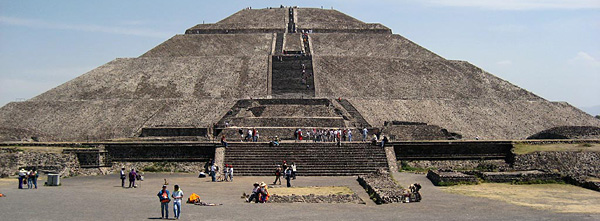
|
 |
 |
 Technology News | January 2008 Technology News | January 2008  
Mexico: Teotihuacan Sun Pyramid in for a Muon Scan
 Diego Cevallos - Inter Press Service Diego Cevallos - Inter Press Service
go to original


| | The Pyramid of the Sun at Teotihuacan was built in the first century AD. It has a base ten feet shorter (on each side) than the Great Pyramid of Cheops, and a volume of 2.5 million tones of stone and earth used in its construction. The alignment of this pyramid was designed to coincide with the two days a year (May 19th and July 25th) when the Sun would be directly over the top of the pyramid at noon. The East facade directly faces the rising Sun, and the West facade directly faces the Sun as it sets. (AdvantageMexico.com) | | |
Mexico City - Who ruled the pre-Columbian city of Teotihuacan, in Mexico? Where are their bodies buried, what ethnic group did they belong to, and what kind of political system did they develop? A project to delve into these mysteries is under way, and may start producing answers next year.

The Sun pyramid at Teotihuacan, which is climbed by about 500,000 tourists a year, will be subjected to a kind of computerised tomography, or CT-scan, to find out if there are tunnels or chambers hidden inside.

The information may help clear up some of the enigmas surrounding a culture that has been heavily studied, but remains little understood.

The pyramid is the largest monument in Teotihuacan. It is as high as a 20-storey building, and has a square base with sides measuring 215 metres each. In order not to disturb the venerable structure, Mexican scientists are going to place muon (subatomic particle) detectors around it, which they will monitor until March 2009.

Muons are produced when cosmic rays hit the Earth’s atmosphere. Like electrons, they are charged particles that will penetrate any kind of material. Dense material deflects muons from their path, whereas they can pass straight through hollow spaces, so a muon scan yields an image similar to an X-ray.

The Institute of Anthropological Research at the National Autonomous University of Mexico (UNAM) and the Physics Institute of the same university have developed six muon detectors for the Sun pyramid.

The detectors, spaced around the pyramid, will count the muons arriving at different spots, and a computer programme will process the information provided by the instruments and produce a three-dimensional map of the pyramid’s interior.

Muons hit the Earth at a rather slow rate, about one muon per square centimetre per minute, which is why it will take several months’ exposure to obtain a good image of the inside of the pyramid.

If cavities are found, they will be excavated in search of key information about the history of the rulers of Teotihuacan, said UNAM archaeologist Linda Manzanilla.

Manzanilla, who is in charge of the project, said that the use of muon detectors at the ancient site has been in the planning stages since 1997.

Archaeologist Fernando Cortés told IPS that the results of the project could be valuable, but that it is also possible that no tunnels or chambers will be found in the pyramid, in which case no progress would be made towards solving the mysteries.

Cortés, who worked for the state National Institute of Anthropology and History in the 1990s, said that at least three tunnels were dug into the Sun pyramid by archaeologists between the 1920s and 1960s, and that no burial chambers were found.

Teotihuacan, a Nahuatl word which means "the place where men become gods", is the name given to the city by the Aztecs. It is located 50 kilometres north of the Mexican capital.

The Aztecs discovered Teotihuacan in about 1300 A.D. No one knows what the city was originally called.

Unlike other cultures, such as the Aztec and Maya civilisations, the people of Teotihuacan left no information about the names of their rulers and dynasties, nor about their forms of government.

According to calculations, the city covered 3,500 hectares and was inhabited by 200,000 people at the peak of its splendour. But no royal tombs or images of any kind of its rulers have ever been found.

At present, 460 hectares are under the protection of the Mexican state, including the main buildings of the ceremonial complex at its centre: the Sun and Moon pyramids, and several temples and platforms.

Other areas are thought to have been used for housing. They flank the Calzada de los Muertos (Avenue of the Dead), which is five kilometres long and between 50 and 100 metres wide.

The city was built before the Christian era, and reached its peak between 450 and 600 A.D. Around 700, its residents all left the city, for unknown reasons.

The Aztecs, impressed by the abandoned buildings, thought they had been built by giants with the aid of the gods, according to historians.

Although there is a certain amount of knowledge about the religious beliefs of the people of Teotihuacan and their relations with other Mesoamerican cultures, nothing is known of their administrative structure or their rulers. Their ethnic origin also remains a mystery.

What archaeologists can say is that Teotihuacan was the largest Mesoamerican city of its time, and its people probably came not only from what is now Mexico, but also from several Central American countries.

Apparently it was a cosmopolitan and multiethnic society, said Cortés. "If the research in hand and the muon detection project at the Sun pyramid are successful, we may make some truly fascinating discoveries in one or two years’ time," he said. | 
 | |
 |



